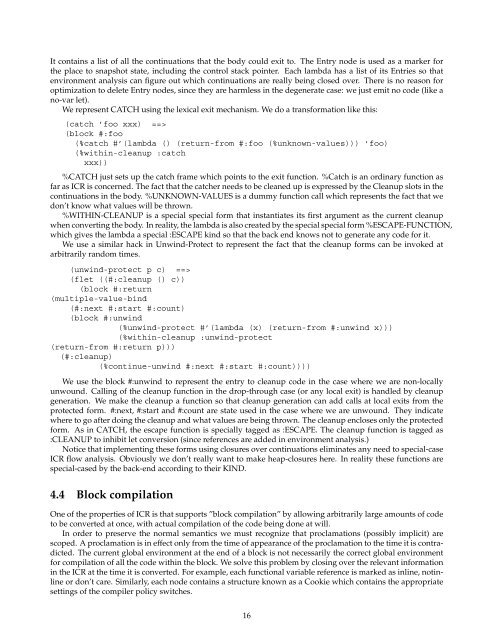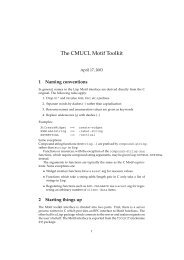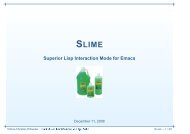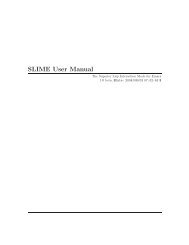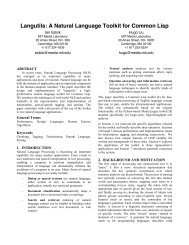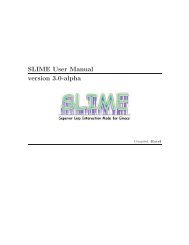Design of CMU Common Lisp.pdf - Common Lisp.net
Design of CMU Common Lisp.pdf - Common Lisp.net
Design of CMU Common Lisp.pdf - Common Lisp.net
You also want an ePaper? Increase the reach of your titles
YUMPU automatically turns print PDFs into web optimized ePapers that Google loves.
It contains a list <strong>of</strong> all the continuations that the body could exit to. The Entry node is used as a marker for<br />
the place to snapshot state, including the control stack pointer. Each lambda has a list <strong>of</strong> its Entries so that<br />
environment analysis can figure out which continuations are really being closed over. There is no reason for<br />
optimization to delete Entry nodes, since they are harmless in the degenerate case: we just emit no code (like a<br />
no-var let).<br />
We represent CATCH using the lexical exit mechanism. We do a transformation like this:<br />
(catch ’foo xxx) ==><br />
(block #:foo<br />
(%catch #’(lambda () (return-from #:foo (%unknown-values))) ’foo)<br />
(%within-cleanup :catch<br />
xxx))<br />
%CATCH just sets up the catch frame which points to the exit function. %Catch is an ordinary function as<br />
far as ICR is concerned. The fact that the catcher needs to be cleaned up is expressed by the Cleanup slots in the<br />
continuations in the body. %UNKNOWN-VALUES is a dummy function call which represents the fact that we<br />
don’t know what values will be thrown.<br />
%WITHIN-CLEANUP is a special special form that instantiates its first argument as the current cleanup<br />
when converting the body. In reality, the lambda is also created by the special special form %ESCAPE-FUNCTION,<br />
which gives the lambda a special :ESCAPE kind so that the back end knows not to generate any code for it.<br />
We use a similar hack in Unwind-Protect to represent the fact that the cleanup forms can be invoked at<br />
arbitrarily random times.<br />
(unwind-protect p c) ==><br />
(flet ((#:cleanup () c))<br />
(block #:return<br />
(multiple-value-bind<br />
(#:next #:start #:count)<br />
(block #:unwind<br />
(%unwind-protect #’(lambda (x) (return-from #:unwind x)))<br />
(%within-cleanup :unwind-protect<br />
(return-from #:return p)))<br />
(#:cleanup)<br />
(%continue-unwind #:next #:start #:count))))<br />
We use the block #:unwind to represent the entry to cleanup code in the case where we are non-locally<br />
unwound. Calling <strong>of</strong> the cleanup function in the drop-through case (or any local exit) is handled by cleanup<br />
generation. We make the cleanup a function so that cleanup generation can add calls at local exits from the<br />
protected form. #:next, #:start and #:count are state used in the case where we are unwound. They indicate<br />
where to go after doing the cleanup and what values are being thrown. The cleanup encloses only the protected<br />
form. As in CATCH, the escape function is specially tagged as :ESCAPE. The cleanup function is tagged as<br />
:CLEANUP to inhibit let conversion (since references are added in environment analysis.)<br />
Notice that implementing these forms using closures over continuations eliminates any need to special-case<br />
ICR flow analysis. Obviously we don’t really want to make heap-closures here. In reality these functions are<br />
special-cased by the back-end according to their KIND.<br />
4.4 Block compilation<br />
One <strong>of</strong> the properties <strong>of</strong> ICR is that supports ”block compilation” by allowing arbitrarily large amounts <strong>of</strong> code<br />
to be converted at once, with actual compilation <strong>of</strong> the code being done at will.<br />
In order to preserve the normal semantics we must recognize that proclamations (possibly implicit) are<br />
scoped. A proclamation is in effect only from the time <strong>of</strong> appearance <strong>of</strong> the proclamation to the time it is contradicted.<br />
The current global environment at the end <strong>of</strong> a block is not necessarily the correct global environment<br />
for compilation <strong>of</strong> all the code within the block. We solve this problem by closing over the relevant information<br />
in the ICR at the time it is converted. For example, each functional variable reference is marked as inline, notinline<br />
or don’t care. Similarly, each node contains a structure known as a Cookie which contains the appropriate<br />
settings <strong>of</strong> the compiler policy switches.<br />
16


